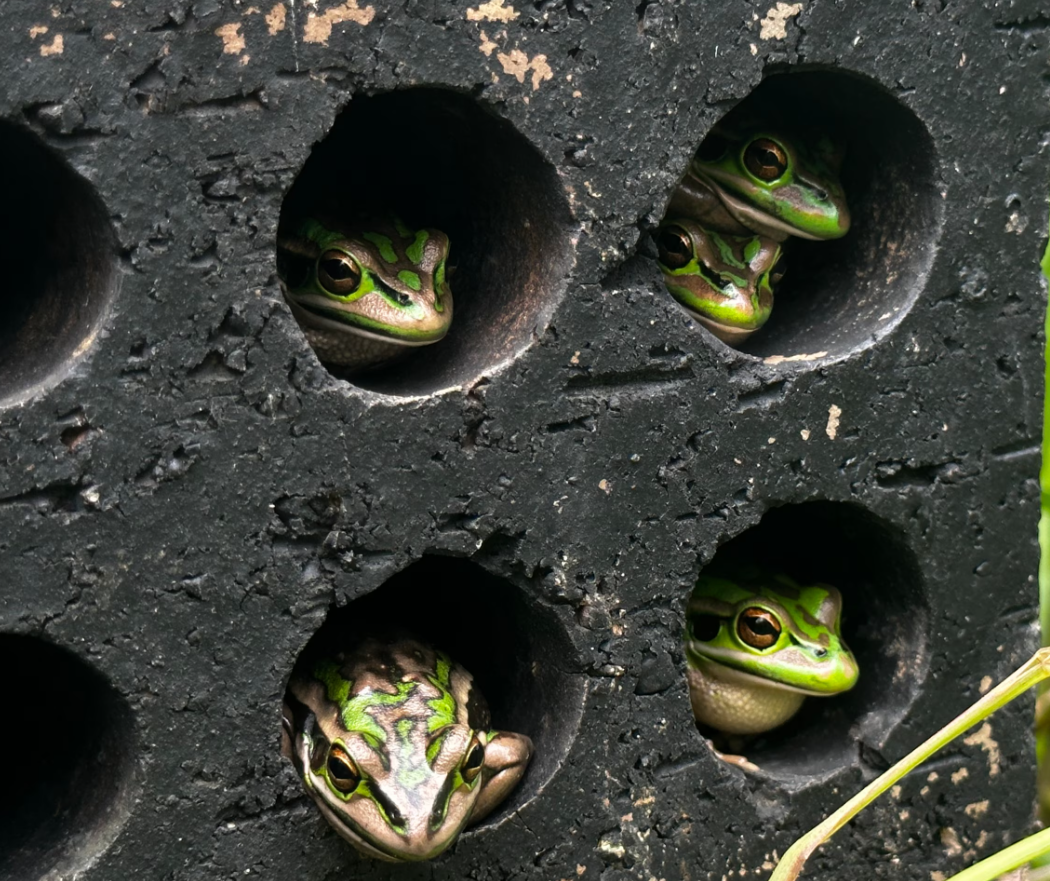The premise was simple: Place 10-hole masonry bricks outside in direct sunlight, right in front of Australian green and golden bell frogs. The heat-loving animals then hopped inside the steamy holes to rest, with just their triangular heads jutting out.

They didn’t know it, but this “spa treatment” saved their lives. By raising the frogs’ body temperatures, the artificial “saunas” helped the infected animals fight off the chytrid fungus, also known as Batrachochytrium dendrobatidis (Bd), a devastating pathogen that has contributed to the extinction of at least 90 amphibian species worldwide and the decline of another 500.
Anthony Waddle, a conservation biologist at Macquarie University in Australia, and colleagues conducted the experiment on the endangered bell frogs, which have dramatically declined due to the fungus. The research was successful: Infected frogs recovered after spending time in the black, sun-heated bricks, and frogs that chose to use the refuges had less severe infections.
What’s more, frogs cured inside the bricks were 23 times more likely to survive another bout of Bd, a fungus that prefers cooler temperatures. The saunas are a simple and affordable intervention—people can even install them permanently outside their homes. (Learn how the discovery of an ‘extinct’ toad offers hope amid chytrid crisis.)
Yet protecting amphibians from the fungus requires creative solutions, and the frog sauna is just one of them, cautions Waddle, whose study appeared recently in the journal Nature.
That’s because chytrid is so widespread that getting rid of it would be “equivalent to eradicating the common cold,” he says—virtually impossible.
A devastating pandemic
First recorded in the 1970s and 1980s, Bd is the most destructive amphibian disease ever known, impacting species around the world, says Waddle. Climate change is now fueling the spread of Bd, for instance northward into European countries.
“It affects an entire tree of life. It’s like if COVID affected all the mammals,” he says.
One of hundreds of chytrid species, Bd spreads in water and by contact with other amphibians. The fungus eats away at the proteins in an animal’s skin, eventually killing them. (See the ‘ground zero’ of the chytrid fungus outbreak.)
Bd doesn’t slaughter every amphibian it meets. Some, like the American bullfrog, are not harmed but still carry the pathogen and spread it to other species. This mysterious aspect of the disease has severely reduced the biodiversity of amphibian species, which in turn harms ecosystem health.
“You’ll never have a world where there’s no frogs left,” says Jonathan E. Kolby, National Geographic Explorer and conservation director at the Honduras Amphibian Rescue and Conservation Center.
Instead, “you’ll have a world where there’s still lots of frogs, but a whole lot less diversity.”
Not a cure-all
Waddle and colleagues plan to test the “frog sauna” system on other species, particularly those in warm climates.
Amphibians living in cooler environments, such as the critically endangered Panamanian golden frog, would be too stressed by the heat to use the brick refuge, he notes. (Read why we know less about the chytrid fungus than we thought.)
“It’s not a cure-all for everything,” Kolby agrees, but “every little bit matters.”
Scientists battling Bd have also developed vaccines that contain weakened forms of chytrid, similar to the original polio vaccine for people.
“It’s a very effective way to prime frogs, especially if you were raising them to be released into the wild,” says Waddle. Scientists have successfully vaccinated wild green and golden bell frogs in Australia’s Sydney Olympic Park and in relict leopard frogs of the Mojave Desert.
Chemical treatments have also shown promise in some species, but, as Kolby notes, these experiments are done in controlled settings, and it is difficult to apply them to wild animals.
Ideally, frogs will evolve mutations to resist the disease. That’s where piecemeal solutions like frog saunas come in: They keep animals alive long enough to adapt to the pathogen—a “kind of a stopgap to buy time,” Waddle says.
“Hopefully,” he adds, “frogs can save themselves.”

